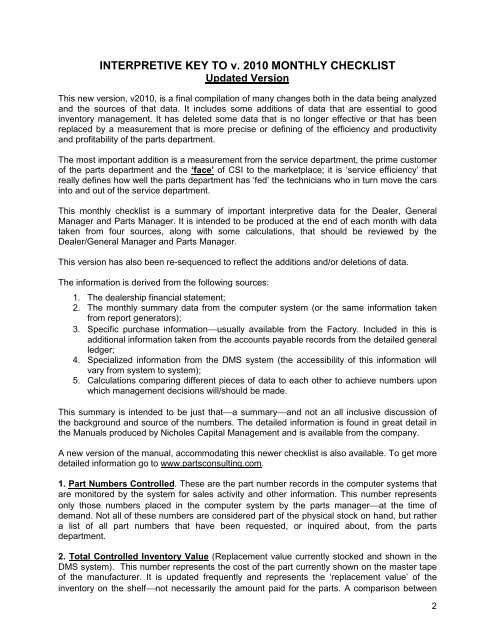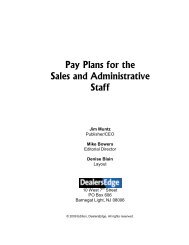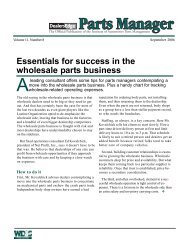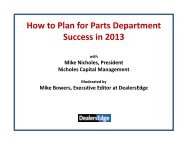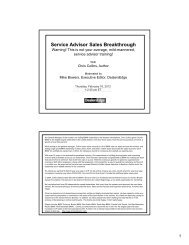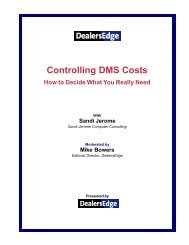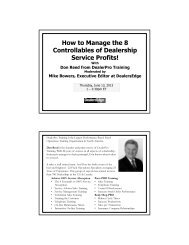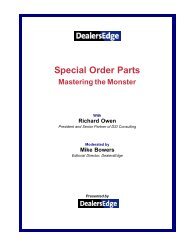How To Avoid Physical Parts Inventory Nightmares - DealersEdge
How To Avoid Physical Parts Inventory Nightmares - DealersEdge
How To Avoid Physical Parts Inventory Nightmares - DealersEdge
Create successful ePaper yourself
Turn your PDF publications into a flip-book with our unique Google optimized e-Paper software.
INTERPRETIVE KEY TO v. 2010 MONTHLY CHECKLISTUpdated VersionThis new version, v2010, is a final compilation of many changes both in the data being analyzedand the sources of that data. It includes some additions of data that are essential to goodinventory management. It has deleted some data that is no longer effective or that has beenreplaced by a measurement that is more precise or defining of the efficiency and productivityand profitability of the parts department.The most important addition is a measurement from the service department, the prime customerof the parts department and the ‘face’ of CSI to the marketplace; it is ‘service efficiency’ thatreally defines how well the parts department has ‘fed’ the technicians who in turn move the carsinto and out of the service department.This monthly checklist is a summary of important interpretive data for the Dealer, GeneralManager and <strong>Parts</strong> Manager. It is intended to be produced at the end of each month with datataken from four sources, along with some calculations, that should be reviewed by theDealer/General Manager and <strong>Parts</strong> Manager.This version has also been re-sequenced to reflect the additions and/or deletions of data.The information is derived from the following sources:1. The dealership financial statement;2. The monthly summary data from the computer system (or the same information takenfrom report generators);3. Specific purchase information⎯usually available from the Factory. Included in this isadditional information taken from the accounts payable records from the detailed generalledger;4. Specialized information from the DMS system (the accessibility of this information willvary from system to system);5. Calculations comparing different pieces of data to each other to achieve numbers uponwhich management decisions will/should be made.This summary is intended to be just that⎯a summary⎯and not an all inclusive discussion ofthe background and source of the numbers. The detailed information is found in great detail inthe Manuals produced by Nicholes Capital Management and is available from the company.A new version of the manual, accommodating this newer checklist is also available. <strong>To</strong> get moredetailed information go to www.partsconsulting.com.1. Part Numbers Controlled. These are the part number records in the computer systems thatare monitored by the system for sales activity and other information. This number representsonly those numbers placed in the computer system by the parts manager⎯at the time ofdemand. Not all of these numbers are considered part of the physical stock on hand, but rathera list of all part numbers that have been requested, or inquired about, from the partsdepartment.2. <strong>To</strong>tal Controlled <strong>Inventory</strong> Value (Replacement value currently stocked and shown in theDMS system). This number represents the cost of the part currently shown on the master tapeof the manufacturer. It is updated frequently and represents the ‘replacement value’ of theinventory on the shelf⎯not necessarily the amount paid for the parts. A comparison between2


